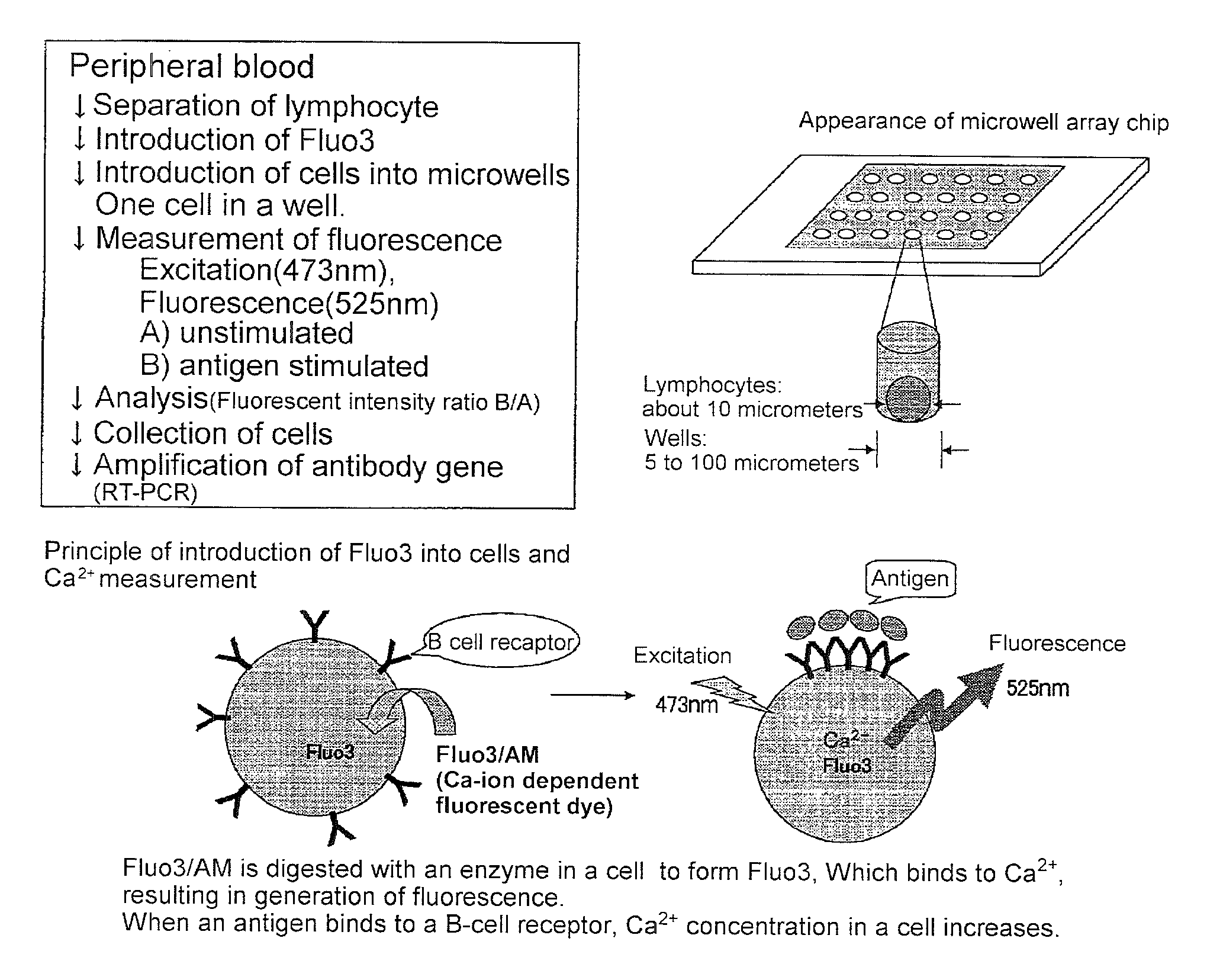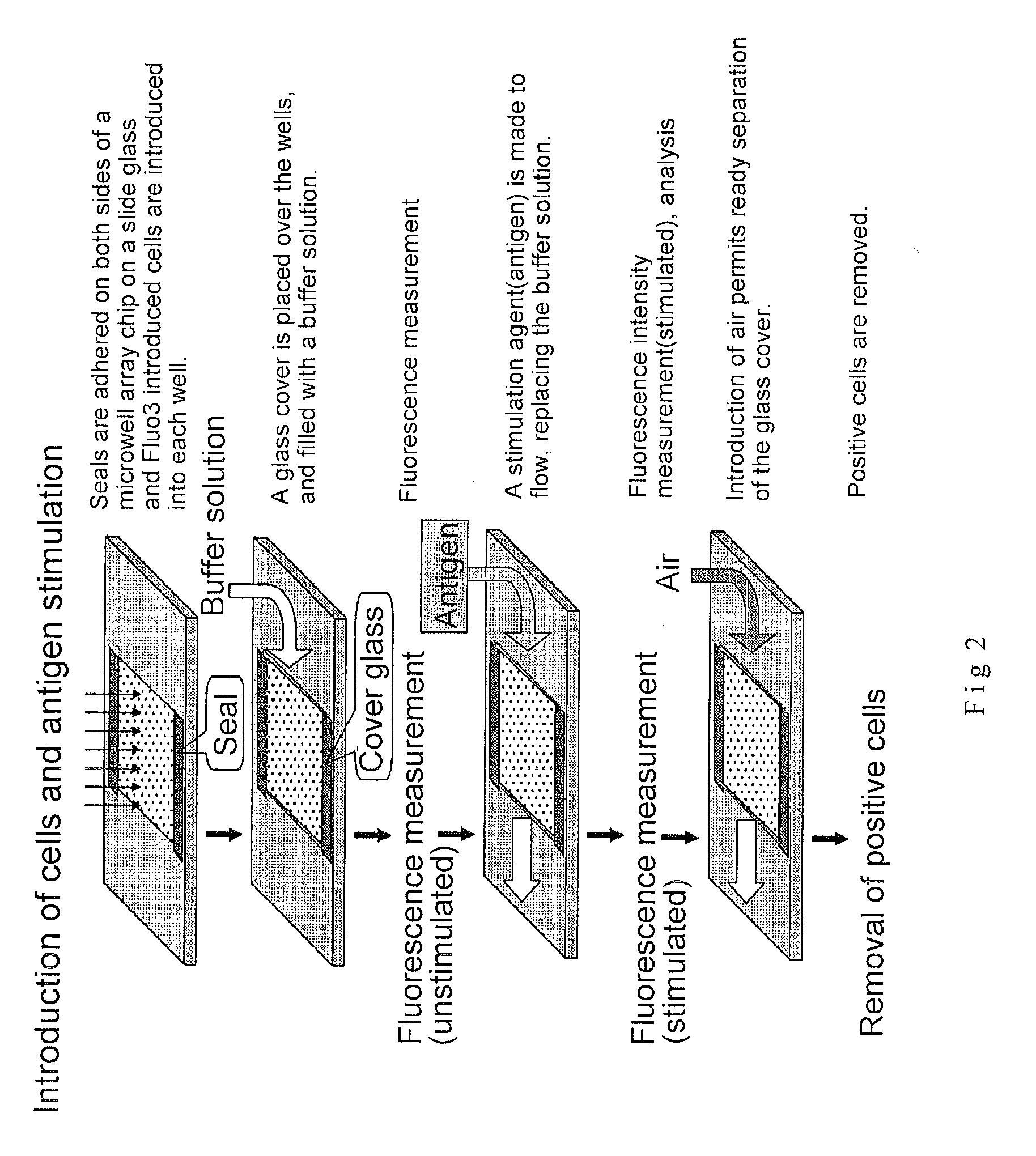Microwell array chip for detecting antigen-specific lymphocytes, method of detecting and method of manufacturing antigen-specific lymphocytes, and method of cloning antigen-specific lymphocyte antigen receptor genes
- Summary
- Abstract
- Description
- Claims
- Application Information
AI Technical Summary
Benefits of technology
Problems solved by technology
Method used
Image
Examples
embodiment 1
1. Separation of B Lymphocytes
[0179]Employing Ficoll-Paque (Pharmacia, Uppsala, Sweden), the lymphocyte fraction was separated from peripheral blood. The B lymphocyte fraction was then further separated and purified from the lymphocyte fraction using an AutoMACS (Miltenyi Biotec, Bergisch Gladbach, Germany)
2. Introduction of Fluo3 into Cells (See FIG. 1)
[0180]2×106 cells of B lymphocyte were suspended in RPMI 1640 / 10 percent FCS solution containing 2 micromoles of Fluo3 / AM (Dojin, Kumamoto) and incubated for 30 min at room temperature. The cells were washed with RPMI 1640 / 10 percent FCS to remove the Fluo3 / AM that had not been incorporated into the cells. Subsequently, the cells were suspended in RPMI 1640 / 10 percent FCS solution.
3. Microwell Array Chip (See FIG. 2)
[0181]The microwell array chip was made of poly(dimethylsiloxane) (PDMS) and had microwells of 10 micrometers in diameter and 32 micrometers in depth arranged horizontally and vertically at a spacing of 30 micrometers (th...
embodiment 2
[0188]The efficiency of introduction of cells into the microwells was examined by fluorescence microscopy or microarray scanning.
[0189]Mouse lymphocytes were fluorescently labeled with CellTracker Orange (Molecular Probe Corp.).
[0190]The mouse lymphocytes were obtained as follows.
[0191]Spleens were extracted from mice and transferred to plastic Petri dishes containing PBS. The spleens were sandwiched between two pieces of mesh and crushed to remove lymphocytes. The lymphocytes that were removed were suspended in RPMI 1640 / 10 percent FCS solution and the number of lymphocytes was counted.
[0192]The fluorescent labeling of the murine lymphocytes was conducted as follows.
[0193]2×106 cells of B lymphocytes were suspended in loading buffer (20 mM HEPES, pH 7.4, 137 mM NaCl, 2.7 mM KCl, 1.8 mM CaCl2, 1 mM MgCl2, 1 mg / mL glucose, 1 mg / mL BSA) containing 1 micromole of CellTracker Orange (Molecular Probes, USA), 0.02 percent of Pluronic F-127 (Molecular Probes, USA) and incubated for 30 min ...
embodiment 3
Detection of Antigen-Specific B Lymphocytes by Microarray Scanner
[0200]A healthy volunteer was inoculated with hepatitis B virus vaccine and B lymphocytes were prepared from peripheral blood on days 4 and 6 by the usual methods. Human B lymphocytes were suspended in buffer (loading buffer (20 mM HEPES, pH 7.4, 137 mM NaCl, 2.7 mM KCl, 1.8 mM CaCl22H2O, 1 mM MgCl2, 1 mg / mL glucose, 1 mg / mL BSA)) containing 4 micromoles of the calcium fluorescence indicator Fluo-4 / AM (Molecular Probes Corp.), 1 micromole of CellTracker Orange (Molecular Probes Corp.), and 0.02 percent of Pluronic F-127 (Molecular Probes Corp.) to introduce Fluo-4 and CellTracker Orange into the cytoplasm. B lymphocytes loaded with Fluo-4 and CellTracker Orange were applied by the same method as in Embodiment 2 onto a microwell array chip identical to that in Embodiment 2.
[0201]Subsequently, the B lymphocytes loaded with Fluo-4 and CellTracker Orange that had been seeded in the microwell array chip were stimulated with...
PUM
| Property | Measurement | Unit |
|---|---|---|
| frequency | aaaaa | aaaaa |
| shape | aaaaa | aaaaa |
| dimensions | aaaaa | aaaaa |
Abstract
Description
Claims
Application Information
 Login to View More
Login to View More - R&D
- Intellectual Property
- Life Sciences
- Materials
- Tech Scout
- Unparalleled Data Quality
- Higher Quality Content
- 60% Fewer Hallucinations
Browse by: Latest US Patents, China's latest patents, Technical Efficacy Thesaurus, Application Domain, Technology Topic, Popular Technical Reports.
© 2025 PatSnap. All rights reserved.Legal|Privacy policy|Modern Slavery Act Transparency Statement|Sitemap|About US| Contact US: help@patsnap.com



